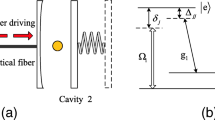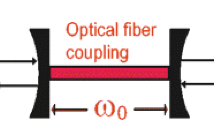Abstract
An interferometer in which an atom traverses two identical micromaser cavities in succession is proposed. Depending on the preparation of the cavity fields, the probability for finding the atom in a definite final state displays Ramsey fringes or not. If the initial cavity fields are such that the state of the atom between the cavities can be determined, then the Ramsey fringes disappear, as is required by the principle of complementarity.
Similar content being viewed by others
References
M.O. Scully, B.-G. Englert, H. Walther: Nature 351, 111–116 (1991)
N.F. Ramsey: Molecular Beams (Clarendon, Oxford 1956)
For a review of the Garching micromaser work consult G. Rempe, M.O. Scully, H. Walther: Physica Scripta T34, 5–13 (1991)
E.T. Jaynes, F.W. Cummings: Proc. IEEE 51, 89–109 (1963)
B.-G. Englert, M.O. Scully: In New Frontiers in Quantum Electrodynamics and Quatum Optics. NATO ASI Series, Series B: Physics, Vol. 232, ed. by A.O. Barut (Plenum, New York 1990) pp. 507–512




